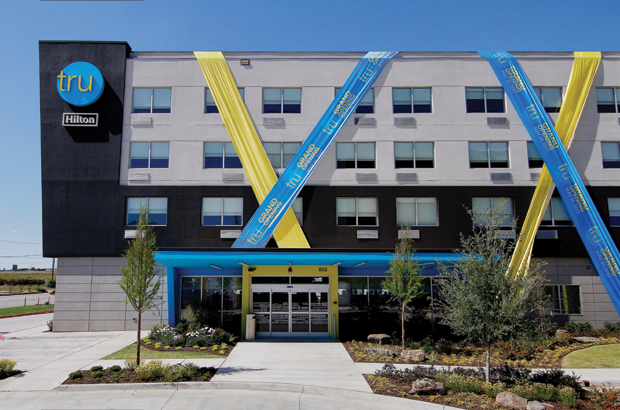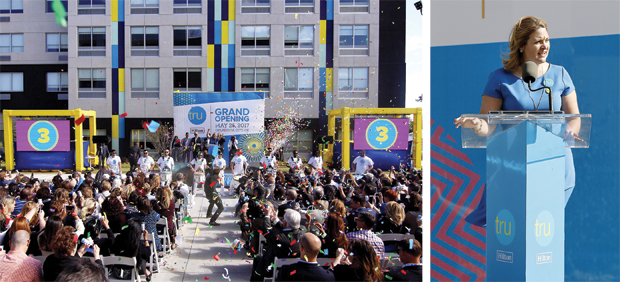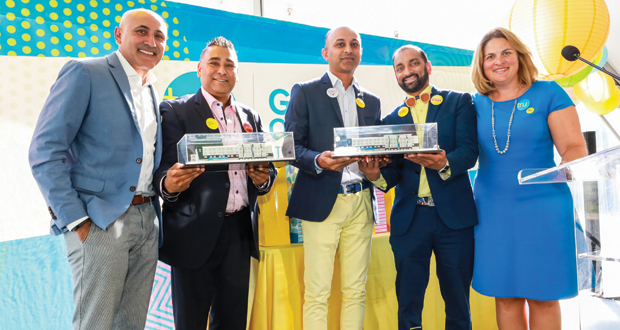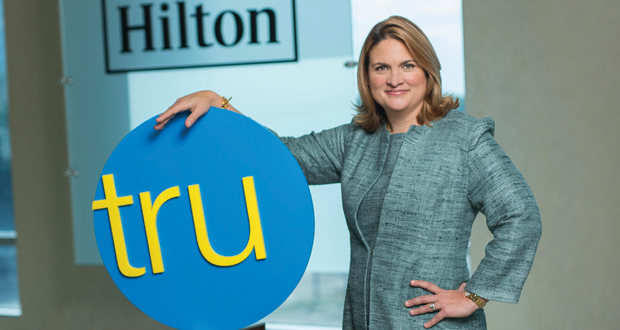Alexandra Jaritz’s office in Hilton’s McLean, Va., global headquarters is filled with colorful souvenirs and mementos. Photographs, trinkets, and awards give the room a welcoming and lived-in vibe, and above it all on a high shelf, in the immediate eye line of anyone who walks by her office, sits a large, wooden, turquoise Tru by Hilton logo. Tru, which is Jaritz’s and her team’s creation, is Hilton’s first foray into the midscale space. And, at this point in time, it’s pretty safe to say that this endeavor has been a massive success for both Jaritz and Hilton.
Now senior vice president and global brand head of Tru by Hilton, Jaritz joined the Hilton team in June of 2015. In January of 2016, she and her team launched Tru. In the two years since, Tru has achieved the fastest growing development pipeline in the history of the hotel industry. At the end of 2017, there were seven Tru properties open for business and an additional 470 hotels in various stages of development. The brand should have more than 250 open and operating hotels by the end of 2019. This sort of growth is unprecedented for a hotel brand that will be celebrating its second birthday at the 2018 Americas Lodging Investment Summit in January 2017.
LODGING caught up with Jaritz to discuss her background, learn the insights behind the Tru brand, and hear about what she has planned for the future of this new lodging juggernaut.
How did you get your start in the hotel industry?
Both of my parents were in the hotel business. My mom was a PR director and my dad was in food and beverage, and then later worked his way up to general manager. It’s been in my genetics from the very beginning. I was born in Germany and then when I was six weeks old, my parents and I moved to Malaysia. From Malaysia, we moved every couple of years and I was fortunate to grow up in amazing countries and cultures including the United Arab Emirates, Jordan, Thailand, and India. I literally lived in a hotel from when I was six weeks old until I went to college. I worked with housekeeping attendants in my free time and usually made an effort to strike up a friendship with the hotel’s pastry chef—I loved to bake and make cookies and chocolates. Chocolate mousse was my favorite!
Anyway, hospitality was just part of how I grew up. I followed my father around and sat with him in his office and he’d tell me about the challenges he was facing operationally. And then of course I wanted to follow in my dad’s footsteps, although I wanted to be more in the corporate side than the day-to-day operations side. I got my degree at the Cornell School of Hotel Administration and then worked on Wall Street to fine-tune my finance background. I also worked for a hospitality feasibility consulting firm in New York, where I worked on market and financial feasibility studies for real estate projects, asset valuations, and development strategies. Then I got my MBA and started working for Choice Hotels, where I stayed for 13 years. Choice was a great opportunity, because I was able to learn and work in a variety of different departments within the company, giving me a broad spectrum of experiences—everything from development to marketing to branding to operations. Eventually, I was a member of the executive leadership team where I oversaw Choice’s branding and marketing organization. I was perfectly positioned to understand what it takes to run a business.

Tru is part of Hilton’s portfolio of brands, but the brand is still run like a business. It’s not just about branding or marketing, it’s making sure we pull the right levers at the right time to meet our business goals. And that’s what really excited me about coming to Hilton, the ability to build something game-changing from scratch. Very rarely do people have an opportunity to build a brand from scratch for an established, venerable institution.
From the beginning, we knew we wanted to develop a brand that would turn the entire midscale segment on its head; we had a clear opportunity to fill a gap in Hilton’s portfolio and reach travelers whose needs weren’t being met by the current midscale segment’s offerings, which were inconsistently executed and generic.
What was it like to build the Tru brand from scratch?
It was an incredible experience. We had the opportunity to start with a blank canvas and upend the midscale segment. To be entrepreneurial with the Hilton name and balance sheet behind us was incredibly exciting. We questioned everything we thought we knew about how a hotel should be built and run. We were always asking questions and pushing our thinking.
With innovation in general, you don’t do things just once; it’s an iterative process. It’s never just, “Aha! This is it!” I wish it was that simple, but it’s not. So we built a team that represented a variety of functional areas, but was still relatively small and agile—always a best practice but in this case, critical because of the very short window we had from concept to launch. This was also imperative because we were simultaneously solving for a game-changing midscale experience for guests, a solid investment for owners, and an energizing experience for our on-property team members.
In developing the brand, we worked with owners to help define Tru by Hilton and bring it to life. We actually had a group of owners that we referred to as our midscale advisors. They have been on this journey with us from the very beginning to give us the owner perspective. We are laser-focused on ensuring Tru drives compelling returns for our owners, so we continue to listen to our owners and incorporate real-time learnings to further value-engineer the Tru by Hilton prototype.
We also did a tremendous amount of market research with consumers to determine what mattered most to them to develop programs, features, a prototype, and a guest experience they would find not only valuable, but game-changing as well. This included qualitative and quantitative research incorporating feedback from thousands of guests, including over 2,000 potential guests experiencing a build-out of the brand and its breakfast service in Memphis.

And, we listened to a lot of different stakeholders—we talked to general contractors, electricians, sound engineers, hotel team members, and the list goes on. We even had them wear our uniforms and asked, “Would you want to wear this?” Literally, we went to that level of iterating and reiterating and doing it on a very compressed timeline. Every step of the way, we changed the game when it came to brand development; we even featured Andre Agassi—a game changer himself—at our brand launch.
It was also imperative that the Tru team worked as a unit at all times. I think we had team members representing at least 20 different functional areas, and I kept telling them, “I don’t want you to think in silos. I don’t want you to be the marketing person. I want you to put your hat on as a guest. Put your hat on as an owner. Put your hat on as if you’re in the development team. Put your hat on as a team member in the hotel—does everything make sense operationally? It created an atmosphere in which everybody was one true team.
How did you find the people who would open the first Tru hotels?
We pitched the concept to a handful of owners who weren’t just visionary hoteliers, but who also were loyal Hilton owners who had experience with our brands. We wanted to be sure that we were working with people who understood what we were trying to create, because it’s a much different product than anything else in our portfolio. And in the market, for that matter.
Why do you think the brand exploded the way it has?
There’s been a white space in the midscale segment, but there is a lot of demand. Forty percent of all room night demand in the United States is for midscale and economy products. And when you look at what products are delivered in that space today, no one’s doing it really well. No one has a consistent, design-forward, and experience-forward product. There’s also a lot of legacy product, which also means there’s a lot of older assets out there.
We were also very clear on what pain points we wanted to eliminate. These included small, dark bathrooms, dearth of lighting in general, small lobbies with no ability to engage guests, and an overall lack of consistency in the midscale space. This is why all Tru properties are new construction. That’s really important because we don’t have to deal with converting legacy products.
And finally, beyond our owner value proposition, we cannot underestimate the power of Hilton’s name and engine. I believe it’s the combination of the open white space, a great value proposition, and the power of Hilton, that drove our pipeline to approach 500 properties in such a short time period.
How have you grown professionally since tackling Tru?
Having to shift from being a visionary requiring high-level decision making, to dealing with the most minute details at an incredibly fast pace was a fantastic challenge. And the fast pace piece here cannot be underestimated. I think that was probably one of the most challenging periods of professional growth for me, because 8 months is not the typical time span for developing and launching a ready-to-build, game-changing hotel brand. The team and I had the opportunity to go from a blank piece of paper, to a ready-to-build concept, to a real operating hotel, and now to a huge pipeline in record-breaking time. It’s truly a once-in-a-lifetime opportunity that has created memories and relationships along the way that will last a lifetime. It’s as much about the journey along the way as the end result.

With such a large pipeline, there is a lot of pressure to make sure these hotels are successful. What steps are you taking to ensure there’s a return on developers’ investments?
As we have done during every step of this brand’s creation, we put ourselves in the position of our owners to understand the full opportunities of an investment in Tru. Our team has worked tirelessly to develop an operating model and standards that successfully align with the market positioning of the brand and needs of today’s travelers. We have identified a set of programs that we believe will help drive top-line revenue growth, particularly during pre-opening and ramp-up phases, focused on driving lead generation, conversion, forecasting, and overall revenue management. As properties open and reach steady-state, we will continue to work with our owners and operators to evaluate additional adjustments we can make to the operating model and our overall support programs, resulting in continuous improvement.
What’s your favorite part of a Tru property?
I have two favorites! The first is the hanging egg chairs in the lobby space. You sit inside and you can swing and put your feet up on an ottoman and just watch the world go by. I love them and so do our guests. When we did ethnographic research, it was the number one chair that people sat in. The other one is the local mural wall, because it gives each hotel a unique local touch and a sense of place. It depicts something special about that location. We’re trying to bring local elements into a more standardized product, and guests really enjoy taking selfies in front of the mural and posting them on their social channels.
Now that Tru is closing in on 500 properties in the development pipeline, how do you feel?
On the personal side, I don’t think it’s fully sunk in yet. We’re so focused on getting it right for our guests and owners. Every single day, that’s what we think about. Maybe one day I will sit in those egg chairs and it’ll really sink in, but it hasn’t yet.
This experience has made the Tru team think differently and everyone on the team has stepped up to the challenge. I believe we have all grown personally and professionally as a result. To create a game-changing brand, you need to challenge the status quo, challenge each other, be comfortable with iterating and adjusting real time, and stay focused on innovating to drive great guest experiences, value for our owners, and a great place to work for our team members. I am thrilled with the success of the brand. Obviously, our strategy is paying off for Hilton, for our owners, and ultimately for our guests. As for me? I am energized by the ability to take Tru to the next level. I thrive on challenges. How do we build on the fastest growing development pipeline? I’m incredibly excited to write the next chapter of this success story.











